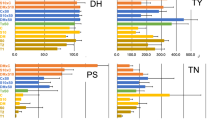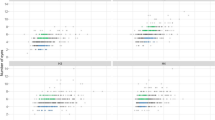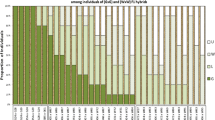Abstract
The wild species of potato do not tuberize under long day conditions making evaluation of their tuber characteristics difficult. HaploidTuberosum × wild species hybrids provide a means of evaluating the tuber characteristics of the 2x, wild species. Seventy-eight haploid × wild species hybrid families were evaluated for yield, specific gravity, percent tuberization per family, general tuber appearance, number of tubers per hill, and dormancy. The wild species parents wereS. bukasovii, S. canasense, S. gourlayi, S. infundibuliforme, S. kurtzianum, S. multidissectum, S. sparsipilum, S. spegazzinii, S. vernei, andS. verrucosum. Variation existed for all traits examined. Percent tuberization per family was greater than 50% in 72 of the families supporting the use of haploids to capture species germplasm for maintenance and evaluation. The mean specific gravity for all hybrids with each of seven species as a parent was greater than 1.085 (acceptable processing level). The analysis of variance for yield indicated that the effect of species parent was significant while the effect of haploids was not. Thirty-eight percent (608 of 1623) of the hybrids which tuberized had eight or more tubers per hill which would allow for further replicated evaluation at multiple locations. Dormancy ranged from 83 to 270 days post-harvest facilitating selection of clones suited to a variety of culture and storage conditions.
Compendio
Bajo condiciones de día largo, las especies silvestres de papa no tuberizan, dificultando la evaluación de las características de sus tubérculos. Los híbridos haploidesTubersosum × especies silvestres proveen un medio de evaluación de las características del tubérculo de las especies silvestres 2x. Se evaluaron setenta y ocho familias híbridashaploide × especie silvestre para rendimiento, gravedad específica, por ciento de tuberización por familia, apariencia general de tubérculo, número de tubérculos por mata, y periodo de reposo. Las especies silvestres tenían como padres aS. bukasovii, S. canasense, S. gourlayi, S. infundibuliforme, S. kurtzianum, S. multidissectum, S. sparsipilum, S. spegazzinii, S. vernei y S. verrucosum. Se encontró variación para todas las características examinadas. El porcentaje de tuberización por familia, fue mayor que 50% en 72 de las familias, justificando el uso de haploides para la captura de germoplasma de especies para mantenimiento y evaluación. El promedio de la gravedad específica para todos los híbridos con cada una de siete especies utilizadas como padres fue mayor que 1,085 (nivel aceptable para el procesamiento). El análisis de la variancia para el rendimiento indicó que el efecto de los padres de la especie fue significativo mientras que el de los haploides no lo fue. Treinta y ocho por ciento (? de 1 623) de los híbridos que tuberization tuvieron ocho o más tubérculos por mata, lo que permitirá continuar con la evaluación con repeticiones en varias localidades. El periodo de reposo varió entre 83 y 270 días después de la cosecha facilitando la selección de clones adaptados a varias condiciones de cultivo y almacenamiento.
Similar content being viewed by others
Literature Cited
Concilio, L. 1985. Evaluation of yield and other agronomic characteristics of TPS families and advanced clones from different breeding schemes. M.S. Thesis. Univ. of Wisconsin-Madison. 63p.
Darmo, E. 1988. Evaluation of 4x clones and families from 4x-2x crosses in potato. M.S. Thesis. Univ. of Wisconsin-Madison. 86p.
De Jong, H. and G.C.C. Tai. 1977. Analysis of tetraploid-diploid hybrids in cultivated potatoes. Potato Res 20:111–121.
Hermundstad, S. and S.J. Peloquin. 1986. Tuber yield and tuber traits of haploid-wild species F1 hybrids. Potato Res 29:289–297.
Hougas, R.W. and S.J. Peloquin. 1962. Exploitation ofSolanum germplasm.In: The Potato and its Wild Relatives. D.S. Correll, Ed. Texas Research Foundation. Renner, Texas. p. 21–24.
Leue, E.F. and S.J. Peloquin. 1980. Selection for 2n gametes and tuberization inSolanum chacoense. Am Potato J 57:189–195.
Peloquin, S.J., G.L. Yerk, J.E. Werner, and E. Darmo. 1989. Potato breeding with haploids and 2n gametes. Genome (in press).
Rudorf, W. 1958. The significance of wild species for potato breeding. Eur Potato J 1:10–20.
Schroeder, S.H. 1983. Parental value of 2X, 2n pollen clones and 4X cultivars in 4X × 2X crosses in potato. Ph.D. Thesis. Univ. of Wisconsin-Madison. 192p.
Steel, R.G.D. and J.H. Torrie. 1980. Principles and procedures of statistics: a biometrical approach. McGraw-Hill. New York. 633p.
Yerk, G.L. and S.J. Peloquin. 1988. 2n pollen in eleven 2x, 2EBN wild species and their haploid × wild species hybrids. Potato Res 31:581–589.
Author information
Authors and Affiliations
Rights and permissions
About this article
Cite this article
Yerk, G.L., Peloquin, S.J. Evaluation of tuber traits of 10,2x(2EBN) wild species through haploid × wild species hybrids. American Potato Journal 66, 731–739 (1989). https://doi.org/10.1007/BF02896829
Accepted:
Issue Date:
DOI: https://doi.org/10.1007/BF02896829




